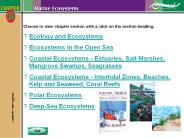Meiofauna PowerPoint PPT Presentations
All Time
Recommended
Meiofauna = Interstitial Fauna. Meiofauna = Interstitial Fauna. Environmental ... Dominated by non-burrowers. Dominated by burrowers. Maximum diversity. No meiofauna ...
| PowerPoint PPT presentation | free to view
... Analysis of the species diversity, community structure and phylogeny of micro-organisms and meiofauna in Mediterranean Deep Hypersaline Anoxic Brines ...
| PowerPoint PPT presentation | free to view
Swash and ... Swash is gentle. Wave energy consumed by the surf. Reflective - wave ... Backwash and swash collide to deposit sediments. Dissipative and ...
| PowerPoint PPT presentation | free to view
... processes affecting biological recovery of benthic meiofauna in response to the ... direct benthic development. Field study. Aim ...
| PowerPoint PPT presentation | free to view
... meiofauna Filtradores mexilh o, ostras, tridacnas, asc dias, esponjas dentre outros Suspens voros poliquetas, espir grafos, vermet deos, corais, ...
| PowerPoint PPT presentation | free to view
BIODEEP IMBC involvement WP 3: Analysis of the species diversity, community structure and phylogeny of micro-organisms and meiofauna in Mediterranean Deep ...
| PowerPoint PPT presentation | free to view
Umbrellas? No solutions at this moment. Impact??? may indirectly lead to solutions ... Sandy beach meiofauna from different geographic areas responds in comparable ...
| PowerPoint PPT presentation | free to view
To monitor the meiofauna/nematode and bacterial communities during one year in ... allow the use of the nematode community as possible bioindicators within the ...
| PowerPoint PPT presentation | free to view
Chapter 13 Intertidal Communities Key Concepts The intertidal zone is the coastal area alternately exposed and submerged by tides. Organisms that inhabit intertidal ...
| PowerPoint PPT presentation | free to view
Estuarine seagrass ecosystems in North Carolina and Florida Seagrasses Angiosperms (flowering plants) that live life entirely underwater Primary productivity is among ...
| PowerPoint PPT presentation | free to download
Title: Einf hrung in die Pal ontologie Author: Peter Frenzel Last modified by: SEA Created Date: 4/29/2002 10:27:33 AM Document presentation format
| PowerPoint PPT presentation | free to view
Benthic systems: Unvegetated Sediments Associations, Diversity, Disturbance ...
| PowerPoint PPT presentation | free to download
Ecological Principles Interactions among animals and the environment What is Ecology? A combination of biotic and abiotic factors Key Ecology Terms Species: natural ...
| PowerPoint PPT presentation | free to view
Chapter 13 Life on the Continental Shelf Life on the Continental Shelf The continental shelf is the submerged edge of a continental plate. The shelf extends from the ...
| PowerPoint PPT presentation | free to download
Depth and stability of oxic-anoxic interface can affect structure of beach infauna ... detect gravity and help animals to orient correctly within sediments ...
| PowerPoint PPT presentation | free to view
Faunal Diversity FISH 7380 Dr. e. irwin Objectives Understand the basic structure of riverine communities Learn broad patterns of faunal diversity across N.AM. river ...
| PowerPoint PPT presentation | free to download
May be an explanation for the low copepod and nematode densities. H2O content of the sediment very high at 4000 m depth in 2002 just as copepod densities. ...
| PowerPoint PPT presentation | free to view
Estuarine Dynamics David Nash and Jenny McDaniel * Birds Salt marsh vegetation serves as a base for reproduction, feeding, and roosting activites - examples: long ...
| PowerPoint PPT presentation | free to download
A detritus fragment trespassing the barriers is less probably removed from waves ... The summer accumulation of organic detritus is associated with a collapse of ...
| PowerPoint PPT presentation | free to download
013 Life on the Continental Shelf SUBTIDAL ABIOTIC FACTORS temperature fluctuates from one area to another especially with depth 1 atm increase in pressure with 10 m ...
| PowerPoint PPT presentation | free to view
'it is considered to be a sandy littoral area open to the sea (excluding ... sand, gravel, shell fractions, sorting coefficient, skewness, kurtosis, %TOM ...
| PowerPoint PPT presentation | free to view
Organismos pseudocelomados Cap tulo 15 Dr. Robert J. Mayer Caracter sticas del f lum Gastrotricha Abdomen velludo Peque os y aplastados (500 m) Se deslizan ...
| PowerPoint PPT presentation | free to download
Projected changes to coastal aquaculture Presented by Timothy Pickering How should we adapt? Build new shrimp ponds where drainage will not be affected by sea level ...
| PowerPoint PPT presentation | free to download
Class Bivalvia: clams, scallops, mussels, oysters; shell with two valves; lack radula and head; most marine; foot reduced or used for digging; include shipworms ...
| PowerPoint PPT presentation | free to view
Chapter 13 Intertidal Communities Key Concepts The intertidal zone is the coastal area alternately exposed and submerged by tides. Organisms that inhabit intertidal ...
| PowerPoint PPT presentation | free to view
Ecology and Ecosystems Ecosystems in the Open Sea Coastal Ecosystems - Estuaries, Salt Marshes, Mangrove Swamps, Seagrasses Coastal Ecosystems - Intertidal Zones ...
| PowerPoint PPT presentation | free to download
Ecology and Ecosystems Ecosystems in the Open Sea Coastal Ecosystems - Estuaries, Salt Marshes, Mangrove Swamps, Seagrasses Coastal Ecosystems - Intertidal Zones ...
| PowerPoint PPT presentation | free to download
... flow, there is more turbulence, and thus more sediment ... From the bottom of the intertidal zone to the continental shelf break. Physical Characteristics ...
| PowerPoint PPT presentation | free to view
Ecology of Freeliving Nematodes
| PowerPoint PPT presentation | free to view
Texas A&M University-Corpus Christi, TX, United States ... Normal Sea Urchin development and Mysid growth rates were inversely related to ...
| PowerPoint PPT presentation | free to view
Unstable and constantly shift in response to tides, waves and currents. No place for organisms to attach. Most animals ... Detritus is the main food source ...
| PowerPoint PPT presentation | free to view
... de representantes de vida livre no solo e raramente aqu ticos Haemonchus contortus Subclasse Diplogasteria Parasita de vertebrados ...
| PowerPoint PPT presentation | free to view
Topography of a typical continental shelf. Characteristics of the habitat ... Higher turbulence than in deep ocean. More variable salinity and temperature ...
| PowerPoint PPT presentation | free to view
... advantages and disadvantages Succession in Hydrothermal Vents New vent forms at diverging plates Chemosynthetic bacteria Amphipods, copepods Grazers/filter ...
| PowerPoint PPT presentation | free to view
Rocky Shore Communities. Where do red and green seaweeds fit into the picture of zonation? ... Rocky Shore Communities. Communities vary from shore to shore ...
| PowerPoint PPT presentation | free to view
... lipids, lower caloric content - more like jellyfish ... The presence of giant organisms in comparison with coastal. regions is a feature of the abyss ...
| PowerPoint PPT presentation | free to view
Move over seafloor (e.g., crabs, snails) Moderate diversity of species ... Crabs abundant in all intertidal zones. Benthic organisms on sediment-covered shores ...
| PowerPoint PPT presentation | free to view
Virginia_Malone@juno.com. 3. Today's Questions. Why test? What is being tested? ... NOT who is a good reader and who is not. NOT who a good test taker and who ...
| PowerPoint PPT presentation | free to download
Longterm Monitoring of Human Impacts McMurdo Station, Antarctica
| PowerPoint PPT presentation | free to view
Mesozoa. Year. Number of species . Octocorallia. Year. Number of species . Pennatulacea. Year. Number of species . Actinaria. Year. Number of species . Antipatharia ...
| PowerPoint PPT presentation | free to download
Substrate (material on the ocean floor where did it come ... Bivalve mollusks. Annelid worms ... Bivalves and other mollusks (infauna) Fiddler ...
| PowerPoint PPT presentation | free to view
BIOFUSE Effects of biodiversity on the functioning and stability of marine ecosystems European scale comparisons www.marbef.org/projects/biofuse
| PowerPoint PPT presentation | free to view
In a study on barnacles, they proposed that rates of settlement may be more ... zone is density dependent with respect to barnacle populations (due to seastars) ...
| PowerPoint PPT presentation | free to view
Soft Substrate Communities: The intertidal and subtidal zones Exposed - sand beaches Protected - sand and mud flats Sand beaches Appear devoid of macroscopic life ...
| PowerPoint PPT presentation | free to view
... and community dominated by snail (Ilyanassa) until amphipods rebuild tubes in spring ... dominates, bioturbation by snails destabilizes sediments, leading ...
| PowerPoint PPT presentation | free to view
... detritus, which then gives back to the food pool such that there is no energy ... To compensate the detritus pool puts back into the food pool, so it basically ...
| PowerPoint PPT presentation | free to view
An example of a multispecies GADGET model for the Celtic Sea. ... Micro-benthos. Sessile. Invertebrates. Cephalopods. Micro- plankton. Pelagic. Bacteria. Phytoplankton ...
| PowerPoint PPT presentation | free to view
Autotrophic--Acquire energy from sunlight & materials from non-organic sources ... Flowering plants. Submersed only where light reaches. Importance ...
| PowerPoint PPT presentation | free to view
Trophic Ecology


















































